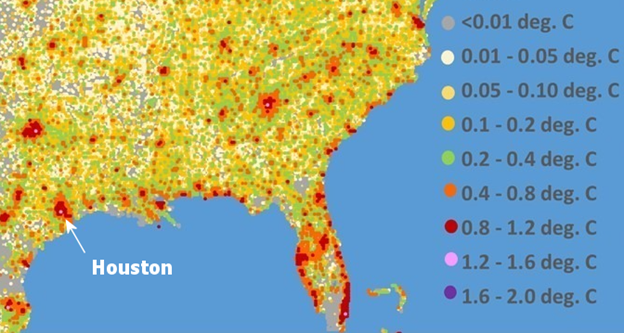A recent article in the Washington Post (WaPo) linked recent heavy rain and an associated explosion of mosquitoes to climate change. Other media outlets such as Fox News, cited the WaPo story saying Mosquitoes swarm Texas town, officials blame climate change. Officials may be blaming climate change, but they are wrong. The WaPo and town officials are conflating weather and climate, and one exceptionally wet spring is not indicative of a long-term climate change trend. Further, history shows us that because of its geography, location, and climate, Houston has always been prime breeding grounds for mosquitoes.
Since the end of the last ice age, the south Texas coastal plain, where Houston lies, has always been hot, humid, and rife with mosquitos.
Still, WaPo’s article consists, in part, of an interview with the director of mosquito control for Houston who said:
“[A]s it gets warmer earlier, we see a larger amount of mosquitoes earlier,” said Max Vigilant, director of mosquito and vector control in Harris County, where Houston is located. “We are getting hotter temperatures earlier.”
“This is the impact that climate change has had on Harris Country,” Vigilant added.
If climate change was in fact a driver for increasing mosquitoes, you’d see it in long-term trend data for mosquito populations. However, just one year ago, Houston Public Media ran a story on a data-driven report showing the number of “mosquito days” in Houston has actually decreased since 1979:
The report showed that Houston has seen an average of 20 fewer mosquito days. According to the analysis, in 1979 Houston had 240 mosquito days. In 2022, it saw 182 mosquito days — a decrease of 58 days.
“Mosquito days” are days ideal for the bugs to thrive in: warm, humid weather. According to the study, mosquitos prefer climates that have an average relative humidity of 42% or higher and daily minimum and maximum temperatures between 50–95°F.
The data, graphed below, shows a distinct downward trend since 1979:
This data completely debunks the claim about the “impact that climate change has had” towards increasing the mosquito problem made by the director of mosquito control for Houston.
Interestingly, among the reasons for the declining mosquito days in the Houston area is actually warmer temperatures. Houston Public Media goes on to say in their story, Houston sees fewer days suitable for mosquitos due to increased temperatures, study claims:
Most of the locations that experienced a decrease in mosquito days are in the South, where summer temperatures frequently exceed the upper range that is suitable for mosquito conditions in the analysis.
Houston is built mostly on swampland, according to this Wikipedia entry:
Houston is located in the Gulf Coastal Plain biome, and its vegetation is classified as temperate grassland. Much of the city was built on marshes, forested land, swamp, or prairie, all of which can still be seen in surrounding areas.
The city has constructed reservoirs and channels to remove rainwater from the area into Galveston Bay and has about 2,500 miles of managed waterways. However, some say that Houston is now a “concrete island floating on top of a swamp.”
So, with that much water, it is no wonder that Houston has always been a mosquito breeding ground. The WaPo article even admits this:
Harris County, where it is warm enough to find the insects year-round, is home to more than 50 species of mosquito. “Houston is never completely mosquito-free,” said Sonja Swiger, an entomologist at Texas A&M.
So, why are the number of “mosquito days” decreasing in Houston?
The most likely reason for this is the rapid urbanization of Houston since 1979. According to Rice University in Houston,
The urban footprint of the Houston metropolitan area increased by 63% from 1997 to 2017. In other words, Houston’s impervious surfaces, like pavement and buildings, grew by about 1,000 km2 in 20 years.
An increased urban footprint does two things that affect the mosquito population over time:
-
- With more impervious surfaces, there’s less swampland and less breeding grounds for mosquitoes.
- The increased urban footprint causes an increase in the Urban Heat Island effect (UHI), and raises temperatures within the city, making it less conducive to mosquitos.
A look at satellite data on UHI from a data-driven study conducted by climatologist Roy Spencer, PhD., shows a very large UHI footprint for Houston as seen in the figure below:
Clearly, the combination of increased infrastructure and increased temperature due to UHI has reduced the number of mosquito days in Houston. The so-called climate change effects cited by WaPo and the director of mosquito control are completely false, as is shown by real world data.
WaPo and Vigilant conflated a short term weather event that created flooding in the Houston area, with long term climate change. Weather is not the same as climate change. The flooding from storms temporarily created more mosquito breeding areas. Because the area’s landscape is relatively flat, many streets are lined with ditches to capture and drain stormwater filled up and did not drain for days. This added plenty of places for ideal mosquito breeding grounds. The same thing happened though not as extreme in 2017, 2018, and 2019.
This is just another instance of activist journalism at work that is tailored to fit a bought and paid for climate crisis narrative that is so often being pushed today in the media. If WaPo’s editors and fact checkers had bothered to do a modicum of research, they would have discovered that there is no merit whatsoever to the claim that climate change is causing an increase in Houston’s mosquito population, rather the problem has declined substantially during recent the period of modest warming.






















